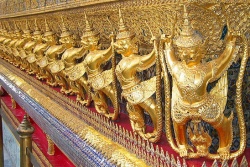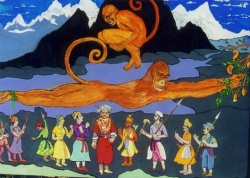Samkhya Theory of Matter by M. P. Rege
1. What may count as the Samkhya theory of matter is part of the general philosophical theory advanced by it which aims at giving a true account of the nature of all that there is.
2. Samkhya divides all things that are there into two radically different kinds: (a) things which possess Consciousness or rather are constituted of Consciousness (cetana); (b) things which are Unconscious (jada) but are objects of (or for) Consciousness.
The latter category includes not only inanimate physical things and physical processes, living things and vital processes, but also minds and Mental acts, occurrences like sensations, wishes and feelings. For, one can be as much aware of one’s feelings and perceptions of things, as of tables and stones. Thus for Samkhya, physical things, organisms and minds fall on one side of the fundamental ontological divide, on the other side of which are to be found only subjects of pure Consciousness (purusa).
Samkhya dualism may be compared with Cartesian dualism which has dominated later Western Thought, according to which the basic ontological division is that between minds which are characterised by Consciousness, and material things which are characterised by extension and motion.
3. The totality of jada things is called Prakrti. Prakrti is one, not only in the formal sense of being the all-inclusive set of all jada things, but also in the sense that it is one causal system. A jada thing exists, in some sense, within Prakrti. It is one Form of the stuff of which Prakrti is composed and is causally linked with other such forms.
4. The ultimate constituents of which Prakrti or all jada things are composed are gunas. The commonest meaning of the Sanskrit word guna is quality. However, as used by Samkhya, guna does not mean quality. A guna is rather a substantive entity. But a guna is not something which possesses quality. Rather a guna is an entity with its own characteristic expression. A guna expresses itself in a certain quale. The total character of a particular thing or process like a pot or a tree or an emotion is the resultant of the qualia in which all the gunas which constitute that thing or process have expressed themselves. Everything or process in prakrti is composed of gunas.
5. Gunas fall into three kinds: Sattva, rajas and tamas. For Samkhya, a jada thing is something which is essentially (a potential) object of Consciousness, an object for some Purusa. The Consciousness of a purusa is likened to Light. This metaphor needs to be taken seriously. For a purusa to be aware of an object is for the object to be illumined with a glow with the Light of the purusa. The contribution which the component of sattva gunas within a jada thing makes to its nature, consists in rendering it illuminable by the Light of a purusa. The sattva gunas are just those gunas which are responsive to the Light of a purusa.
A composition of gunas which is capable of being illumined by the Light of a purusa is a Mental Phenomenon. It has this nature and capability because there is a preponderance of sattva gunas in its composition. When a Mental Phenomenon which is in itself Unconscious (jada) is illumined by the Light of a purusa, it becomes a conscious experience. Opposed to sattva gunas are the tamas gunas. (Tamas means darkness.) Tamas gunas resist the Light of a purusa; they are opaque to it. They thus constitute the principle of materiality. A material thing is one which has a preponderance of tamas gunas in it. However, a material thing can become an object for Consciousness indirectly even though not directly. Sattva gunas in addition to being translucent are plastic. As a Mind is predominantly composed of sattva gunas, it can assume, because of the plasticity which it possesses, the Form of a material thing. A Mental formation of this sort when illumined by the Light of a purusa becomes a conscious Perception of the physical object.
The third kind of gunas, the rajas gunas, express themselves in motion. They constitute the dynamic principle in Prakrti. Tamas gunas in addition to resisting the Light of a purusa also resist the force exerted by rajas gunas. They make for inertia. As a material thing is mainly constituted of tamas gunas it is inert. As against this, even though a Mental Phenomenon is overwhelmingly composed of sattva gunas it also contains a component of tamas gunas. A Mental state, e.g., a Perception of a pot has a determinate nature which it maintains at least for a brief while. This implies that it successfully resists being transformed into another sort of Mental state. This is made possible by the presence of tamas gunas in it.
Every Phenomenon in Prakrti is an admixture of all the three kinds of gunas, and the proportions in which they are blended in it determine its character. Things cannot be separated from one another by assigning them to different species or sorts, each with a sharp boundary. They rather Form a continuous gradation stretching from the most tamasika things to the most sattvika.
Further, as each thing contains a component of rajas gunas, it is continuously changing. The picture of Prakrti — ‘Nature’ — which Samkhya presents is not that of a totality of things each of which has its own rigid identity which it maintains for a longer or shorter duration, is endowed with a determinate nature of its own and acts uniformly on other things in accordance with its intrinsic nature. The identity of a particular thing — a material thing or a Mind — is akin to the identity of a wave. Nature is like an ocean in which waves arise and subside and are continued in subsequent waves. One may note that this is largely a similar picture to that presented by Buddhism or Advaita Vedanta.
6. A human person, indeed any jiva (a living organism) consists of a purusa, and a Mind-Body complex to which it is related. The purusa is the transcendental element in jiva; the Mind-Body complex falls squarely within Prakrti. The Mind, the Body to which it is linked, and the environment within which the Mind-Body complex is set and acts, are different formations of the same stuff of which everything in Prakrti is composed. The Body can function as an organ of the Mind, and the Mind-Body complex can deal effectively with the environment because of their essential homogeneity. Thus, if Purusas are excluded the Samkhya view of things is monistic and naturalistic.
7. The last point: According to Samkhya there is a teleology inherent in Prakrti, which has a reference to the purposes of purusas. Whatever happens in Prakrti happens for the sake of purusas. Prakrti in its original state exists as an entity which was totally devoid of any specific character. This is so because the expression of every guna in it is exactly nullified by the expression of some other guna which counters it, so that no specific character emerges as the resultant. From this pristine condition Prakrti evolves into the kind of World-order which is familiar to us: a World, consisting, on the one hand, of diverse kinds of material things which change in accordance with causal laws and, on the other, Mind-Body complexes, each of which is associated with a distinct purusa, and by Virtue of this association is capable of perceiving things, Feeling pleasures and pains, and the Desires they prompt, and acting in order to satisfy these Desires. It is within such a World-order that the purposes of purusas can be effectively served. These purposes are of two sorts: (a) to enjoy diverse experiences (Bhoga) and (b) to be liberated from association with Prakrti (apavarga).
The teleology of Prakrti has a Moral aspect. The diverse experiences which happenings in Prakrti provide to Purusas are determined by their past karmas. And the supreme end of a purusa which Prakrti serves is his Liberation (apavarga or moksa). The Samkhya vision when considered in its entirety is spiritualistic in the peculiarly Indian Form of spiritualism.



